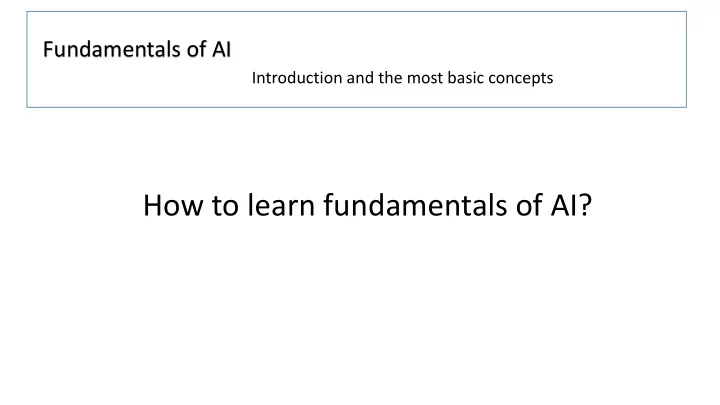

Fundamentals of AI Introduction and the most basic concepts How to learn fundamentals of AI?
Useful books*** *** It is a joke
Any AI (ML) method in two lines of code in any programming language from libraryA import modelB as model model.fit(X,Y) model.predict(X) The rest is either data pre- processing or presenting the results…
Useful books *** *** now not a joke
Tons of YouTube channels and other stuff… What is valuable in learning with a teacher: structuring, pinpointing, highlighting difficulties, expert’s opinion: ASK QUESTIONS!!!
Andrew G. Moore’s tutorials • http://www.cs.cmu.edu/~awm/
Andrew Ng’s Coursera course on machine learning • https://www.coursera.org/learn/machine-learning
AI in France, French opinion-makers … and many others!
Main difficulty (and – may be - mistake) of learning machine learning and AI • Machine learning as a zoo of methods (better to learn ‘animal classification’) • No unifying theory so far (probability theory, but… Vapnik-Chervonenkis computational learning theory, but… ) • ‘> model.fit(X,Y) >model.predict (X)’ trap • What one should undestand before and for studying ML and AI: Linear algebra (vectors and matrices!), Methods of optimization, Probability theory, Functional analysis, Graph theory
Main current myth • No need in all this zoo of machine learning methods • No need to understand math behind • One just need DEEP LEARNING • However, despite the hype, deep learning probably accounts for less than 1% of the machine learning projects in production right now. Most of the recommendation engines and online adverts that you encounter when you browse the net are not powered by deep learning. Most models used internally by companies to manage their subscribers, for example churn analysis, are not deep learning models. The models used by credit institutions to decide who gets credit do not use deep learning.
My objectives in this course: • That you can ‘classify’ a new species (method) in ML -based AI • That you can start reading WikiPedia, search StackOverflow and quiery Google in meaningfull and targeted way • That you would see gears behind ‘ model.predict(X,Y); model.fit (X)’
Two principal approaches to data mining (or statistics or AI or ML) 1) Hypothesis about underlying probability distribution main notion is probability density (PDF) 2) Geometrical approach to the data analysis main notion is metrics ( distance )
High-dimensional post-classical world: Big Data, , Bigger Dimension D. Donoho, from Stanford University webpage • The number of attributes p >> The number of examples N • This post-classical world is different from the ‘ classical world ’. • The classical methodology was developed for the ‘classical world’ based on the assumption of p < N , and N → ∞ . • These results all fail if p > N . • The p > N case is not anomalous; it is the generic case. Donoho, D.L. High-Dimensional Data Analysis: The Curses and Blessings of Dimensionality. Invited Lecture at Mathematical Challenges of the 21st Century, AMS. 13
High-dimensional post-classical world: Big Data, , Bigger Dimension D. Donoho, from Stanford University webpage • The number of attributes p >> The number of examples N • This post-classical world is different from the ‘ classical world ’. • The classical methodology was developed for the ‘classical world’ based on the assumption of p < N , and N → ∞ . • These results all fail if p > N . • The p > N case is not anomalous; it is the generic case. Donoho, D.L. High-Dimensional Data Analysis: The Curses and Blessings of Dimensionality. Invited Lecture at Mathematical Challenges of the 21st Century, AMS. 14
High-dimensional post-classical world: Big Data, , Bigger Dimension D. Donoho, from Stanford University webpage • The number of attributes p >> The number of examples N • This post-classical world is different from the ‘ classical world ’. • The classical methodology was developed for the ‘classical world’ based on the assumption of p < N , and N → ∞ . Solution 1: Return to classics (dimensionality • These results all fail if p > N . reduction) • The p > N case is not anomalous; it is the generic case. Solution 2: Exploit the properties of high-dimensions Donoho, D.L. High-Dimensional Data Analysis: The Curses and Blessings of Dimensionality. Invited Lecture at Mathematical Challenges of the 21st Century, AMS. 15
Recommend
More recommend